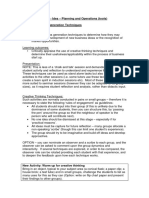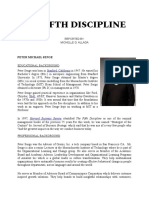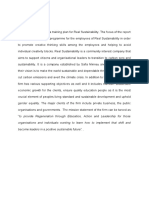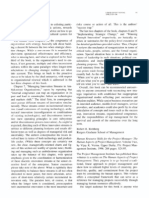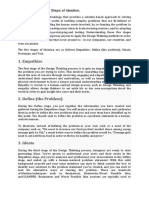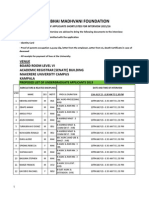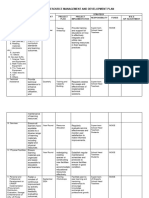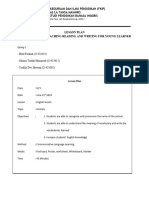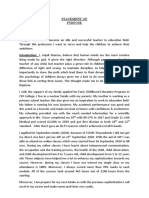ProQuestDocuments 2024 02 14
ProQuestDocuments 2024 02 14
Uploaded by
y9cyhsjvkgCopyright:
Available Formats
ProQuestDocuments 2024 02 14
ProQuestDocuments 2024 02 14
Uploaded by
y9cyhsjvkgOriginal Title
Copyright
Available Formats
Share this document
Did you find this document useful?
Is this content inappropriate?
Copyright:
Available Formats
ProQuestDocuments 2024 02 14
ProQuestDocuments 2024 02 14
Uploaded by
y9cyhsjvkgCopyright:
Available Formats
Innovation in all things!
Developing creativity in the
workplace
Sharman, Dave; Johnson, Almeric
ProQuest 文档链接
摘要
This study states the need for all managers into the next millennium to innovate and respond in new ways. Sets out
a way in which managers can act differently in order to create a creative climate within their work groups. It sets this
practical approach in the context of research carried out by Goran Ekvall on the creative climate of groups. And, it
describes a sequence of activities, discovered by the authors, that was effective in stimulating the group problem-
solving climate and a technique for bringing back this atmosphere. The study outlines this sequence, called
"RAJiMAR" as the letters stand for the various stages of the group problem-solving process: Reversal-Absurdity-
Jokes-incubation-Metaphor-Anchoring-Recall.
全文文献
Dave Sharman: Organizational Development consultant, a personal performance coach and an Associate Lecturer
on the Open University's Creative Management module, part of the MBA. He can be contacted on 0181 305 2196
Almeric Johnson: Chartered Mechanical Engineer, an Organizational Behaviourist and a personal performance
coach
Why do we need to innovate?
Many books and management experts have predicted a world into the next millennium of rapidly increasing change
and the need for managers to be able to respond in ways that have not been previously imagined. In this article we
set out a way in which both managers and trainers can act differently in order to create a creative climate within their
organization. In addition, this practical and insightful technique, partly based on neuro-linguistic programming, is set
in the context of research carried out by Ekvall (1991) on the creative climate of a work group.
We assume that a good test of any organization's current ability to innovate would be to ask such questions as:
- who is responsible for systematically collecting information on the external business environment?
- how is it then distributed to those managers who can use it effectively in their work (and modify their current
assumptions)?
- how many departments besides R&D are judged on their ability to introduce innovations in their policies and
procedures?
- does the organization provide training programmes in both organizational leadership and creativity?
由 PROQUEST.COM 生成的 PDF Page 1 of 6
What do managers need to do differently?
Into the next millennium competitive advantage is likely to arise from organizations that can demonstrate to the
customer such things as:
- speed of response;
- choice;
- rapid improvement in products and services;
- "service added on to products";
- lifelong learning for their staff;
- distinctive competence.
In summary, the key challenges facing management into the next millennium are:
- how to stimulate continuous innovation and change;
- how to adopt radical innovative approaches to organizing and managing;
- how to attract and retain people's know-how.
How to develop a creative climate in the work group
Ekvall (1991) in Sweden noticed in the early 1980s that the level of involvement in suggestion schemes changed in
different parts of the same company. One of the strongest factors influencing people's involvement in idea
suggestion schemes was their perception of the working climate. This was termed organizational climate by Ekvall.
He then began to focus his research into climate variations associated with creativity and innovation. As a result he
developed a 50-item multiple-choice questionnaire which measures people's perceptions of their organizations. He
has now completed over 25 studies on the validity and reliability of this measure and has found a great deal of
support for the use of the measure.
He has completed research into what is a creative climate for the management of ideas. This is a much broader
concept than R&D management, as ideas are sought from all quarters. Idea management has two sides. One
concerns general features of the organization which stimulate or hamper innovation, the other includes special
formal systems and procedures for idea finding and use.
Climate has to do with behaviour, attitudes and feelings which are fairly easily observed. The 50-item questionnaires
set out to measure ten main dimensions of a creative climate such as:
- (1) challenge;
- (2) freedom;
由 PROQUEST.COM 生成的 PDF Page 2 of 6
- (3) idea support;
- (4) trust;
- (5) dynamism;
- (6) playfulness;
- (7) debates;
- (8) conflicts;
- (9) risk taking;
- (10) idea time.
In general the innovative organization scores more highly on these ten dimensions than the stagnated one.
Ekvall concludes from his research that:
- (1) no idea-handling system can work successfully without a supportive climate in the dimensions just listed;
- (2) an idea-handling system can make a good climate even better;
- (3) if the climate is already bad, then an idea-handling system will simply make it worse.
Practical experience - a new creative process for use with groups?
At a recent residential workshop on creativity and problem solving, we discovered a sequence of activities that was
both effective at the time in stimulating the right climate as well as a technique for bringing back this atmosphere.
We have called it "RAJiMAR" as the letters stand for the various stages of the group problem-solving process.
"R A J i M A R" - a way to bring back a creative climate
- R for reversal. A group of people are at the problem definition stage, at an appropriate moment, suggest a
technique known as reversal, in which the problem is turned on its head. e.g. "How to increase the number of
complaints about the xyz company!" This leads everyone quite quickly into...
- A for absurdity! At this point people start to relax, can easily see the humour of the absurdity and start to invent or
think up even more silly situations, which then lead into...
- J for jokes, or "funny phrases" to sum up the situation. The facilitator now needs to accentuate this feeling or
atmosphere by encouraging even funnier words or phrases to sum up the situation, e.g. "lager man" or "bar-stool
man".
- I for incubation. At this stage it is possible to move on to another topic, go for a walk or break off your activity to do
something completely different, thus putting the ideas into everyone's unconscious minds for a period.
由 PROQUEST.COM 生成的 PDF Page 3 of 6
Next time you get together to work on a group problem, remind the group of the "funny phrase" and with their help
develop an...
- M for metaphor - for the absurd, jokey and creative atmosphere previously experienced, e.g. "stirring up a hornet's
nest". Sometimes you can have a friendly competition to generate ideas; and a consensus exercise to choose the
most appropriate metaphor for the experience. Now...
- A for anchor - those memories of that specific creative climate by briefly taking participants back to the pictures,
sounds and feelings, and repeating the key phrase again, e.g. "bar-stool man", etc.
- R for repeat the metaphor.
- R for repeat the sounds again.
- R for recall the visual picture.
- R for reactivate the feelings.
Thus you have completed the RAJiMAR sequence!
Problem-solving workshops in organizations
After reflection on these experiences, we have designed a two-day workshop for use in organizations that is flexible
and relevant to the needs of the participants.
A typical two-day workshop
- (1) Establishing rapport with the group. We use quite rapid and unusual ways of getting into rapport with the group
with a focus on "What is creativity?" and an emphasis on the fact that anyone can learn to be more creative. It is not
just for artists and writers.
- (2) Challenging the barriers to creativity. This flows quite naturally on from the first period and involves everyone in
a series of simple and challenging puzzles or problems, which quite often include reversal in order to stimulate the
creative climate as early as possible. At some stage we introduce the "six-step model of creativity" as a way of
explaining that everyone does use it as a normal part of everyday reality.
- (3) Sharing of problems/issues. This stage flows quite naturally as the group is now beginning to be more open,
energetic and creative.
The next steps then follow a logical sequence as follows:
- (4) Select and then use a creativity technique. Usually for a minimum of 2.5 hours to ensure that real progress is
made.
- (5) Develop a solution. Sometimes this will only be reaching agreement on the next steps to be taken on the
problem.
由 PROQUEST.COM 生成的 PDF Page 4 of 6
- (6) Review the process used. This is a key and often neglected stage in which lessons or principles about the
group are clarified and agreed so that criteria for the problem-solving process can be brought forward next time that
the group works together. Thus we focus on "learning to learn" from experience.
Outcomes
It is the organizations that are already coping with massive rates of change that will appreciate the value of this
approach to solving problems and developing a more creative climate at work. In our experience a company facing a
situation confronted by the possibility of big redundancies managed to turn round their perception and take action so
that they saved Pounds 1.2 million on computerization and no redundancies whatsoever.
Reference
1. Ekvall, G. (1991, "The organizational culture of idea-management: a creative climate for the management of
ideas", in Henry, J. and Walker, D. (Eds), Managing Innovation, Sage..
Further reading
2. Lauer, K., Isaksen, S. and Dorval, B., "Exploring the relationship between creative climate and leadership: a
preliminary report", Communique - The Creative Problem-Solving Group, Vol II, July 1996.
3. O'Connor, J. and Seymour, J., Introducing Neuro-Linguistic Programming, Crucible, 1990.
索引
主题: Studies; Managers; Creativity; Problem solving; Competitive advantage; Workshops;
Innovations; Research &development--R &D
业务索引编制术语: 主题: Competitive advantage Workshops
分类: 9130: Experimental/theoretical; 6200: Training &development
标题: Innovation in all things! Developing creativity in the workplace
作者: Sharman, Dave; Johnson, Almeric
出版物名称: Industrial and Commercial Training; Guilsborough
卷: 29
期: 3
页: 85-87
页数: 0
由 PROQUEST.COM 生成的 PDF Page 5 of 6
出版年份: 1997
出版日期: 1997
出版商: Emerald Group Publishing Limited
出版地: Guilsborough
出版物国家/地区: United Kingdom, Guilsborough
出版物主题: Business And Economics--Management, Business And Economics--Personnel
Management
ISSN: 00197858
e-ISSN: 17585767
CODEN: ILCTAU
来源类型: 学术期刊
出版物语言: English
文档类型: Feature
DOI: https://doi.org/10.1108/00197859710165074
ProQuest 文档 ID: 214108534
文档 URL: https://www.proquest.com/scholarly-journals/innovation-all-things-developing-
creativity/docview/214108534/se-2?accountid=14511
版权: Copyright MCB UP Limited (MCB) 1997
最近更新: 2023-11-25
数据库: ProQuest Central
链接
Linking Service
数据库版权 2024 ProQuest LLC。 保留所有权利。
条款与条件 联系 ProQuest
由 PROQUEST.COM 生成的 PDF Page 6 of 6
You might also like
- Janet E. Esposito M.S.W.-In The SpotLight - Overcome Your Fear of Public Speaking and Performing-Strong Books (2000) PDFDocument172 pagesJanet E. Esposito M.S.W.-In The SpotLight - Overcome Your Fear of Public Speaking and Performing-Strong Books (2000) PDFAmina Salihu100% (1)
- Basic 2 - Unit 12Document36 pagesBasic 2 - Unit 12y9cyhsjvkgNo ratings yet
- 1,2,3Document15 pages1,2,3sivaNo ratings yet
- Ideation EntrepreneursDocument13 pagesIdeation EntrepreneursAbhiranjan SinhaNo ratings yet
- Tec3001 - Module 3Document32 pagesTec3001 - Module 3kartiksh1610No ratings yet
- Design ThinkingDocument29 pagesDesign ThinkingGAURAV MALOONo ratings yet
- Creativity For Chemical EngineersDocument15 pagesCreativity For Chemical EngineersDonald Cuadros CondoriNo ratings yet
- Lecture3 Reading-Design ThinkingDocument8 pagesLecture3 Reading-Design Thinkingraanasoltani76No ratings yet
- Making Better Decisions Using Systems Thinking: How to stop firefighting, deal with root causes and deliver permanent solutionsFrom EverandMaking Better Decisions Using Systems Thinking: How to stop firefighting, deal with root causes and deliver permanent solutionsNo ratings yet
- Chapter 2 Ideation and Concept DevelopmentDocument15 pagesChapter 2 Ideation and Concept DevelopmentAna Marie B. SarmientoNo ratings yet
- Chapter 1Document5 pagesChapter 1Brian CandelariaNo ratings yet
- f1 Creative Problem Solving Cpa and Socratic QuestioningDocument5 pagesf1 Creative Problem Solving Cpa and Socratic QuestioningManel VazquezNo ratings yet
- Teachers Notes A6 - Idea - Planning and Operations (Tools) Session A6 - Idea Generation TechniquesDocument8 pagesTeachers Notes A6 - Idea - Planning and Operations (Tools) Session A6 - Idea Generation TechniquesRavi AnchaNo ratings yet
- The Fifth Discipline: Peter Michael SengeDocument7 pagesThe Fifth Discipline: Peter Michael SengeMichelle Gonzales Allaga-Vicente100% (1)
- The Scamper Technique: Knowledge SolutionsDocument4 pagesThe Scamper Technique: Knowledge SolutionsADB Knowledge SolutionsNo ratings yet
- Design Thinking ProcessDocument6 pagesDesign Thinking Processeka chamidahNo ratings yet
- Altered Perspective: Search Strategies for Innovators (Volume 1)From EverandAltered Perspective: Search Strategies for Innovators (Volume 1)No ratings yet
- What Is Design Thinking and Why Is It So Popular?Document9 pagesWhat Is Design Thinking and Why Is It So Popular?Aniket JainNo ratings yet
- Building LO MarquardtDocument287 pagesBuilding LO MarquardtDedi Seprinra ArfieNo ratings yet
- BookDocument16 pagesBookSemi StephenNo ratings yet
- Strategic Thinking: success secrets of big business projectsFrom EverandStrategic Thinking: success secrets of big business projectsRating: 5 out of 5 stars5/5 (1)
- Seeing Your Company As A SystemDocument11 pagesSeeing Your Company As A SystemCarol Victoria CaroNo ratings yet
- Action Learning, Kaizen and Corporate Culture: Reflect DoDocument13 pagesAction Learning, Kaizen and Corporate Culture: Reflect DoAmerico AzevedoNo ratings yet
- Lecture 1. Module Overview and Pre-Assessment Clinic SEM 2Document23 pagesLecture 1. Module Overview and Pre-Assessment Clinic SEM 2jkleNo ratings yet
- Creativity Awareness ProgrammeDocument6 pagesCreativity Awareness ProgrammegaurineleoNo ratings yet
- Plotting Your Scenarios: Jay Ogilvy and Peter SchwartzDocument20 pagesPlotting Your Scenarios: Jay Ogilvy and Peter SchwartzPatricia DavisNo ratings yet
- Thesis Case Study SampleDocument6 pagesThesis Case Study Samplekellylindemannmadison100% (2)
- What Is Design Thinking and Why Is It So PopularDocument6 pagesWhat Is Design Thinking and Why Is It So PopularWeld Lucas CunhaNo ratings yet
- Real Sustblty 19 AugustDocument7 pagesReal Sustblty 19 Augustkochanparambil abdulNo ratings yet
- Assessment Task 1:: NPV Present Value of Total Future Benefits - Present Value of Total Future CostsDocument13 pagesAssessment Task 1:: NPV Present Value of Total Future Benefits - Present Value of Total Future Costsmuhammad saqib jabbarNo ratings yet
- Top 10 Social Innovation PracticesDocument4 pagesTop 10 Social Innovation PracticesCarlos H PerezNo ratings yet
- Student Name: Programme: DateDocument12 pagesStudent Name: Programme: DateMuqarrub Ali KhanNo ratings yet
- SOLUTION OF UNIT 1 AND UNIT 2 LongQnsDocument16 pagesSOLUTION OF UNIT 1 AND UNIT 2 LongQnsshivamojhadecentNo ratings yet
- Managing Grey Decision MkingDocument13 pagesManaging Grey Decision MkingChristopherArjayCigaralNo ratings yet
- Creativity For EngineersDocument5 pagesCreativity For EngineersUn Chubacca YetiNo ratings yet
- Change Theories An OverviewDocument12 pagesChange Theories An OverviewRanjit RajanNo ratings yet
- Creativity For Engineers: Vvv@imm - Dtu.dk WWW - Imm.dtu - DK/ VVVDocument5 pagesCreativity For Engineers: Vvv@imm - Dtu.dk WWW - Imm.dtu - DK/ VVVAnonymous AMjDOJ0lNo ratings yet
- The Human Aspects of Project ManagementDocument2 pagesThe Human Aspects of Project Managementapi-370709150% (2)
- Twa2007 v3n3 Soft SkillsDocument3 pagesTwa2007 v3n3 Soft SkillssababathyNo ratings yet
- Flaviano Celaschi Design of Organizational Innovation ScenariosDocument8 pagesFlaviano Celaschi Design of Organizational Innovation ScenariosValuedesignresearchNo ratings yet
- 1265problem SolvingDocument15 pages1265problem SolvingTheencyclopediaNo ratings yet
- Case Study AnalysisDocument15 pagesCase Study AnalysisMarwa A.fattahNo ratings yet
- Organizational BehaviourDocument85 pagesOrganizational BehaviourzackyzzNo ratings yet
- Fifth DisciplineDocument5 pagesFifth DisciplineAmit RajNo ratings yet
- Solution Manual For Organizational Communication Balancing Creativity and Constraint 8th Edition Eisenberg Trethewey LeGreco Goodall 1319052347 9781319052348Document36 pagesSolution Manual For Organizational Communication Balancing Creativity and Constraint 8th Edition Eisenberg Trethewey LeGreco Goodall 1319052347 9781319052348vincentriddleizcnkewyms100% (36)
- Senge Fifth DisciplineDocument17 pagesSenge Fifth DisciplineNurmawati100% (6)
- Dynamic DialogueDocument2 pagesDynamic DialogueWangshosan100% (1)
- AuditDocument14 pagesAuditclashofclans00811No ratings yet
- GoalsDocument11 pagesGoalsAditya Aji PrabowoNo ratings yet
- Radical Innovation and Design Research: Kari T. Eloranta, Asko Riitahuhta and Mikko KarvinenDocument5 pagesRadical Innovation and Design Research: Kari T. Eloranta, Asko Riitahuhta and Mikko KarvinenJoao CardosoNo ratings yet
- Different Contribution of The Parts To A WholeDocument12 pagesDifferent Contribution of The Parts To A WholeNicole Guadalupe100% (3)
- Creativity Training ModuleDocument17 pagesCreativity Training ModulemilenebrNo ratings yet
- Module 18Document3 pagesModule 18Franklin BayaniNo ratings yet
- Management of Technology and InnovationDocument4 pagesManagement of Technology and InnovationPrateek KansalNo ratings yet
- Creative ThinkingDocument6 pagesCreative ThinkingDimitrios Koutelis100% (1)
- Intelligent OrganizationsDocument242 pagesIntelligent OrganizationsDavid Guzmán Vásquez100% (1)
- Design Thinking MethodologyDocument8 pagesDesign Thinking MethodologyNahomy ManzanaresNo ratings yet
- McKinsey On Organization Culture and Change PDFDocument44 pagesMcKinsey On Organization Culture and Change PDFalirtaheri7299No ratings yet
- Basic 3 - Unit 11Document39 pagesBasic 3 - Unit 11y9cyhsjvkgNo ratings yet
- OPW PPT - L2 - U3 - Lesson1Document23 pagesOPW PPT - L2 - U3 - Lesson1y9cyhsjvkgNo ratings yet
- Basic 2 - Unit 4Document39 pagesBasic 2 - Unit 4y9cyhsjvkgNo ratings yet
- Basic 2 - Unit 6Document39 pagesBasic 2 - Unit 6y9cyhsjvkgNo ratings yet
- Basic 2 - Unit 7Document39 pagesBasic 2 - Unit 7y9cyhsjvkgNo ratings yet
- RH - GKA - Unit3 - L3 - Snowman - S - Dream - 0221 - Ys - Ys - 200304181835 - 200907115223 - 201116112955Document26 pagesRH - GKA - Unit3 - L3 - Snowman - S - Dream - 0221 - Ys - Ys - 200304181835 - 200907115223 - 201116112955y9cyhsjvkgNo ratings yet
- Basic 1 - Unit 9Document37 pagesBasic 1 - Unit 9y9cyhsjvkgNo ratings yet
- Basic 1 - Unit 6Document36 pagesBasic 1 - Unit 6y9cyhsjvkgNo ratings yet
- RH - GKB - U3 - L3 - Who - Is - The - Best - Kelly - 200403175140Document22 pagesRH - GKB - U3 - L3 - Who - Is - The - Best - Kelly - 200403175140y9cyhsjvkgNo ratings yet
- RH - GKA - Unit2 - L5 - Let - S - Cook - Coco - 0108 - 200115113832 - 201022165529Document23 pagesRH - GKA - Unit2 - L5 - Let - S - Cook - Coco - 0108 - 200115113832 - 201022165529y9cyhsjvkgNo ratings yet
- The Familial Context of Children'S Creativity: Parenting Styles and The Climate For Creativity in Parent-Child RelationshipDocument25 pagesThe Familial Context of Children'S Creativity: Parenting Styles and The Climate For Creativity in Parent-Child Relationshipy9cyhsjvkgNo ratings yet
- 1B-S-5 Page74-89Document17 pages1B-S-5 Page74-89y9cyhsjvkgNo ratings yet
- PU2-U1 词汇2Document22 pagesPU2-U1 词汇2y9cyhsjvkgNo ratings yet
- 1A-S-4 Page58-73Document16 pages1A-S-4 Page58-73y9cyhsjvkgNo ratings yet
- Cedefop 2013 (Read Chapter 3)Document174 pagesCedefop 2013 (Read Chapter 3)y9cyhsjvkgNo ratings yet
- Journal Pone 0294915Document21 pagesJournal Pone 0294915y9cyhsjvkgNo ratings yet
- Bray & Varghese (2011)Document300 pagesBray & Varghese (2011)y9cyhsjvkgNo ratings yet
- Critiquing An ArticleDocument10 pagesCritiquing An ArticleIlliani FazrienNo ratings yet
- Early Childhood Literacy and Numeracy: Building Good PracticeDocument40 pagesEarly Childhood Literacy and Numeracy: Building Good PracticeKARLA GABRIELA PEREZ CORDOVANo ratings yet
- Syllabus 2019-2020 (Retorika)Document11 pagesSyllabus 2019-2020 (Retorika)Michael MosendeNo ratings yet
- Muljibhai Madhvani FoundationDocument13 pagesMuljibhai Madhvani FoundationThe Campus Times100% (1)
- Masters in Architecture SyllabusDocument25 pagesMasters in Architecture SyllabusfruslswwwNo ratings yet
- LRMD Plan TemplateDocument3 pagesLRMD Plan TemplateMae Ann Base RicafortNo ratings yet
- Audit Manajemen - Bab 10 Audit LingkunganDocument23 pagesAudit Manajemen - Bab 10 Audit LingkunganDeviyanti PutriNo ratings yet
- Innovation TemplatesDocument12 pagesInnovation TemplatesPearl AdamosNo ratings yet
- Consider The View That Spoken Language Is More Important Than The Written Form - DadDocument2 pagesConsider The View That Spoken Language Is More Important Than The Written Form - Dadwongkmjason0% (1)
- Labour and Employment Department Policy Note On Labour, Factories, EmploymentDocument60 pagesLabour and Employment Department Policy Note On Labour, Factories, EmploymentsubhasishmajumdarNo ratings yet
- Lesson Plan Group 1 Practice Teaching Reading and WritingDocument4 pagesLesson Plan Group 1 Practice Teaching Reading and WritingFawwaz FauzanNo ratings yet
- Octest 2 Part 2Document8 pagesOctest 2 Part 2Kelly WangNo ratings yet
- New CSC Checklist TVLDocument2 pagesNew CSC Checklist TVLMeynard BaptistaNo ratings yet
- Algebra 1 Placement Exam Study Guide 2011 PDFDocument15 pagesAlgebra 1 Placement Exam Study Guide 2011 PDFCher Jay-ar Doronio100% (1)
- Law Office ManagementDocument2 pagesLaw Office ManagementSundeep KashyapNo ratings yet
- KanchipuramDocument23 pagesKanchipuramvvenkat27No ratings yet
- Early Marriage Policy BriefDocument15 pagesEarly Marriage Policy BriefEka MNo ratings yet
- West-Moynes MaryLynn H 201206 PHD ThesisDocument368 pagesWest-Moynes MaryLynn H 201206 PHD Thesisdiana_vataman_1100% (1)
- Work Ethic RubricDocument1 pageWork Ethic Rubricapi-285097096No ratings yet
- BEGC-103_E_Block-3Document46 pagesBEGC-103_E_Block-3nadimalam78692No ratings yet
- RINA SURYANI - 58430780 - OkDocument14 pagesRINA SURYANI - 58430780 - OkMukhlisIbrahimNo ratings yet
- Geography IA Sample 1 - Elizabeth KitangeDocument15 pagesGeography IA Sample 1 - Elizabeth KitangeElizabeth Mihailovna100% (2)
- ICSE Class - X Maths Booklet With Model Paper 2015Document24 pagesICSE Class - X Maths Booklet With Model Paper 2015Apex Institute100% (3)
- TLE Cookery7-8 Week4Document4 pagesTLE Cookery7-8 Week4Karen Arisga DandanNo ratings yet
- IE 6840 Week 6 HW - 5 GY2876 PDFDocument3 pagesIE 6840 Week 6 HW - 5 GY2876 PDFBharat DarsiNo ratings yet
- Balancing Act Homework Activity 1 and 2Document7 pagesBalancing Act Homework Activity 1 and 2mheojhun100% (1)
- Blog 1Document2 pagesBlog 1api-330219476No ratings yet
- Anjali New SopDocument4 pagesAnjali New SoppallaviNo ratings yet
- Pre-Placement Training Program: Task SheetDocument3 pagesPre-Placement Training Program: Task SheetRevanth GupthaNo ratings yet












